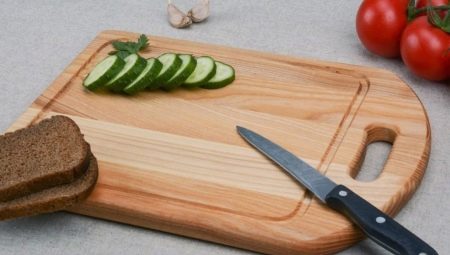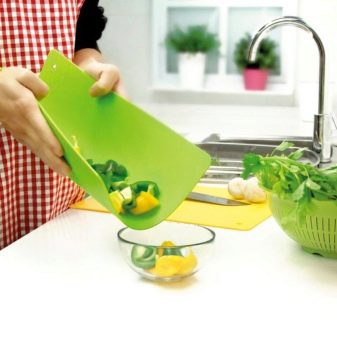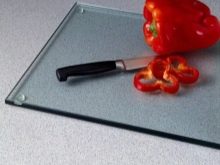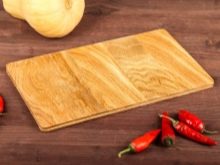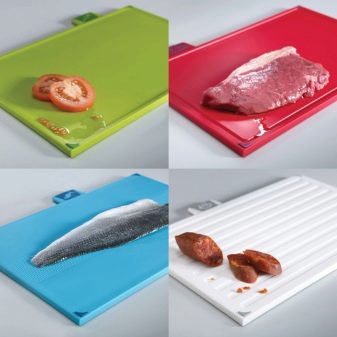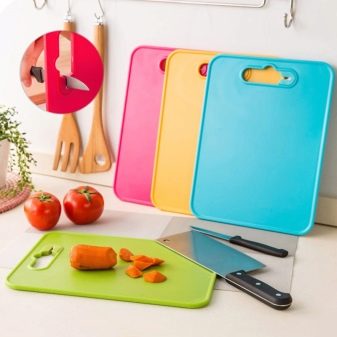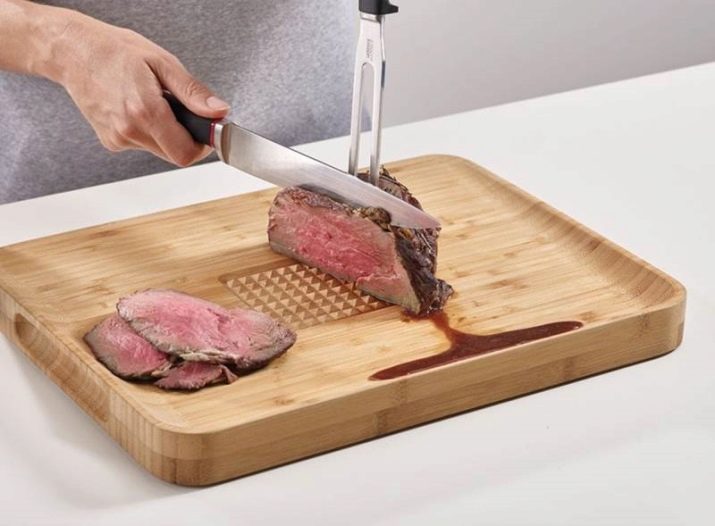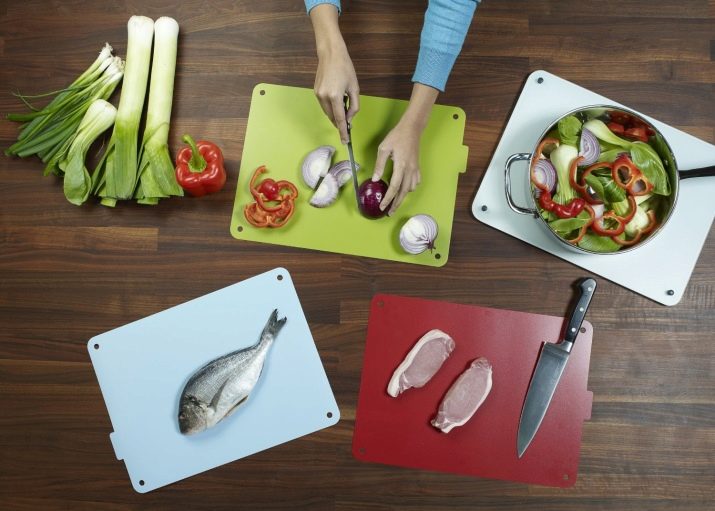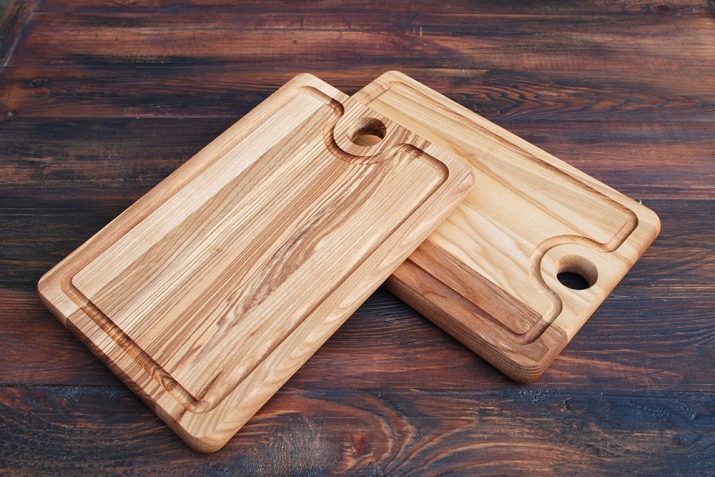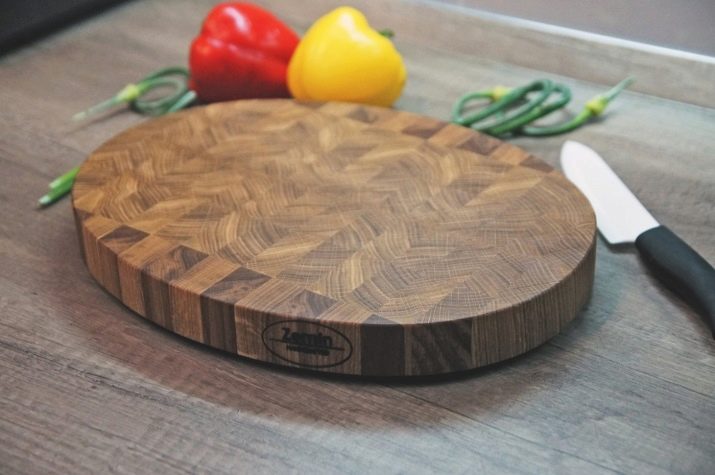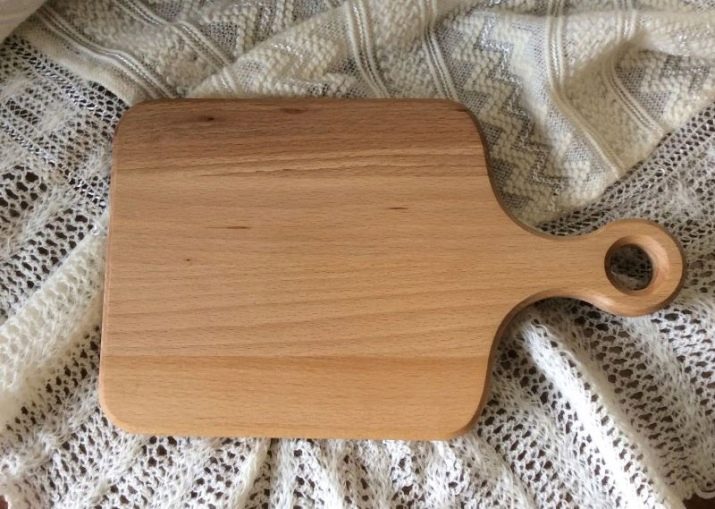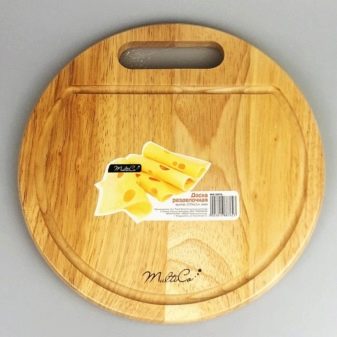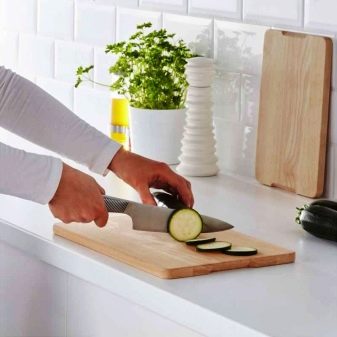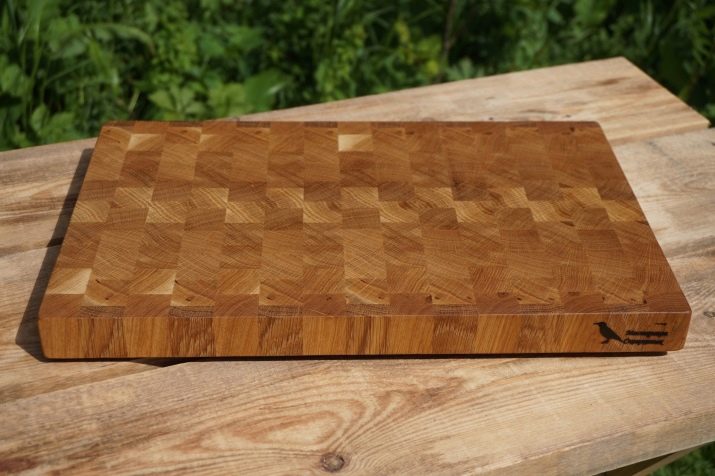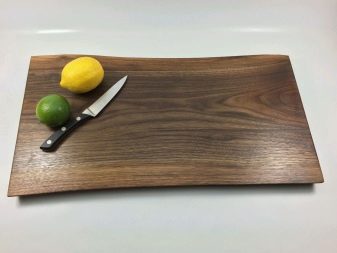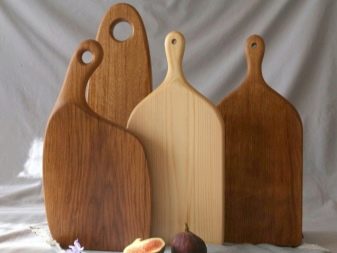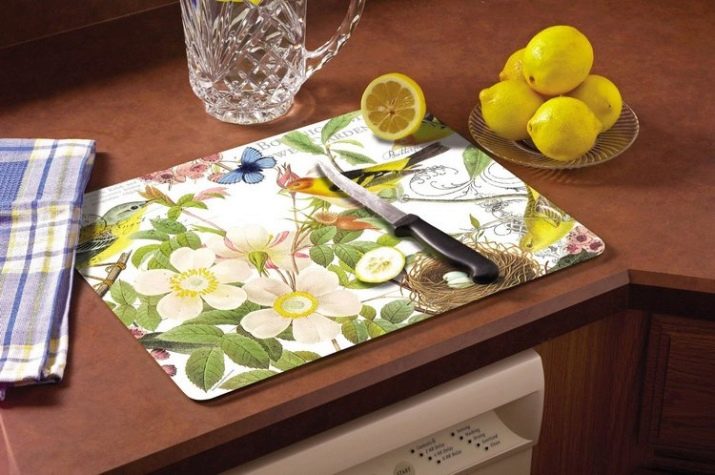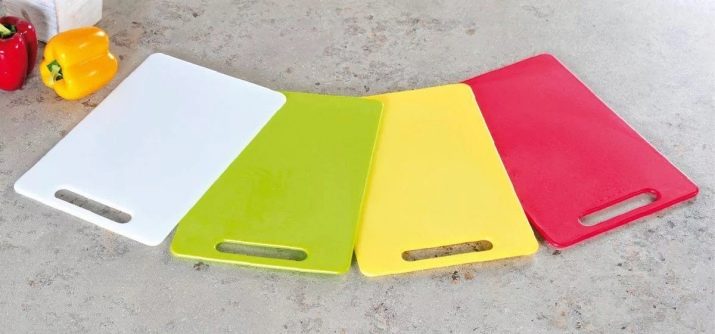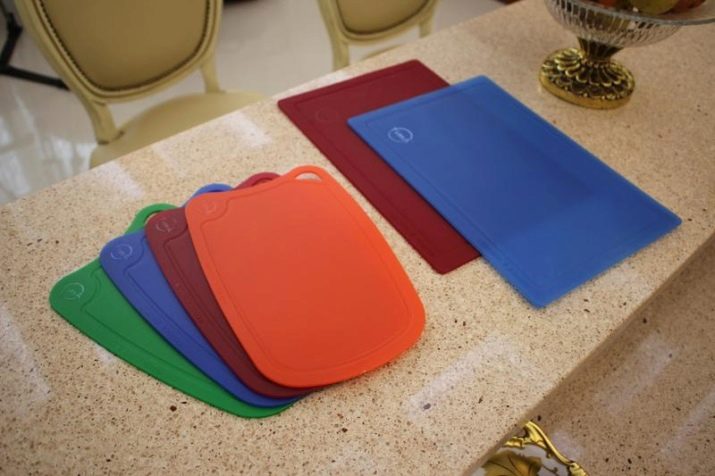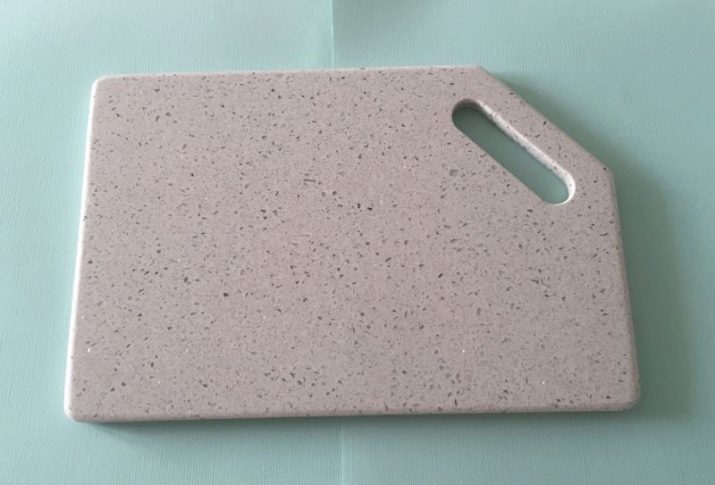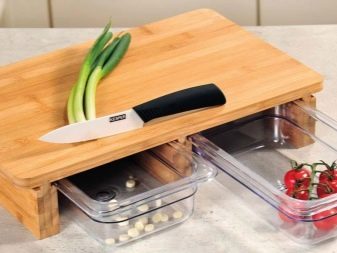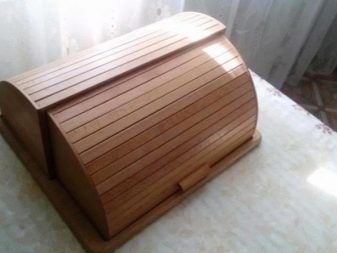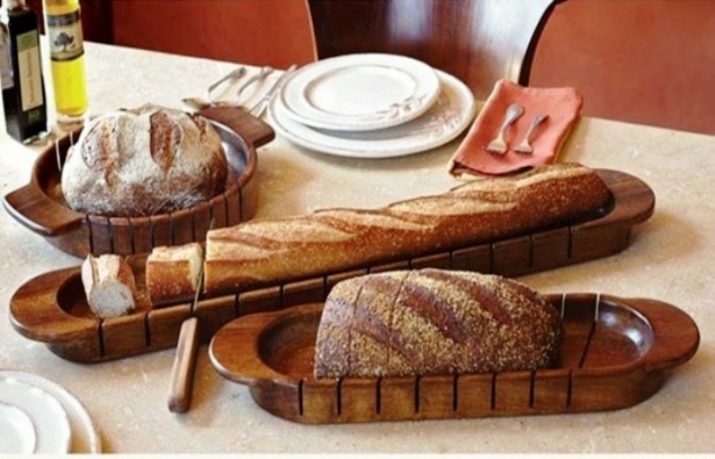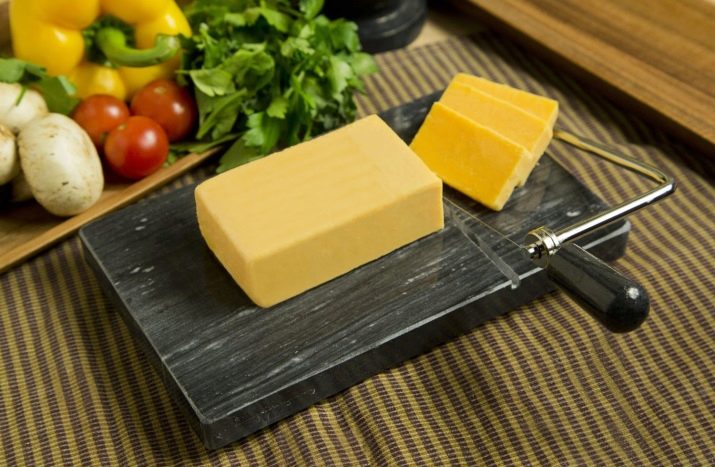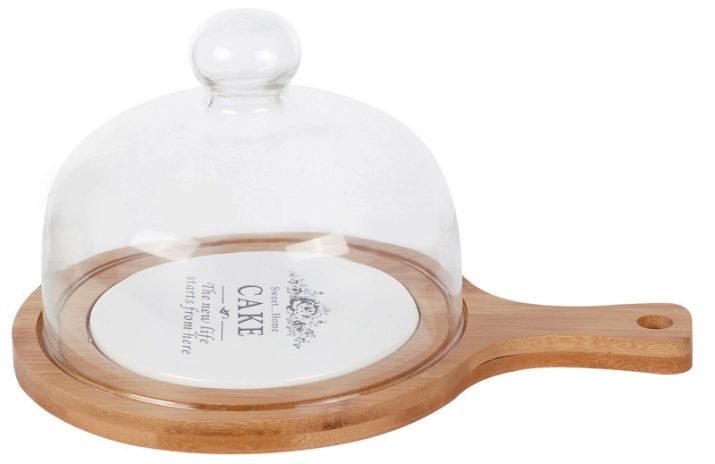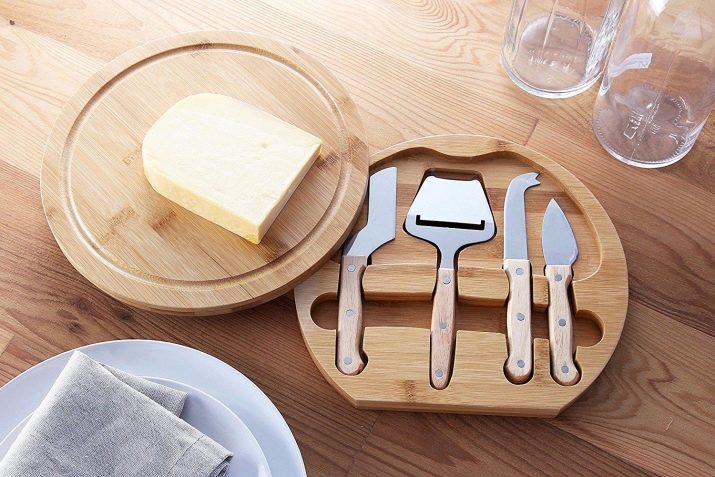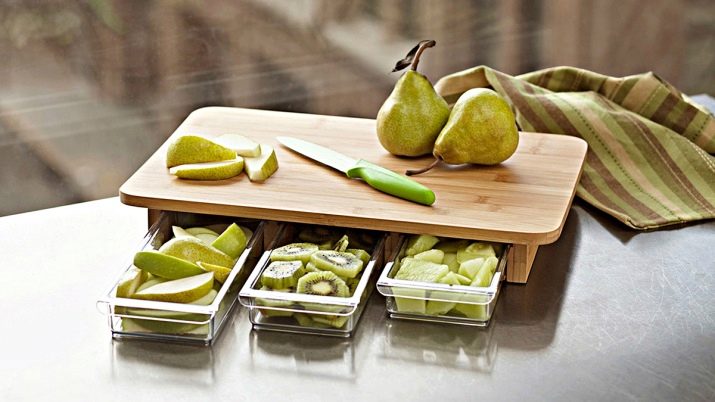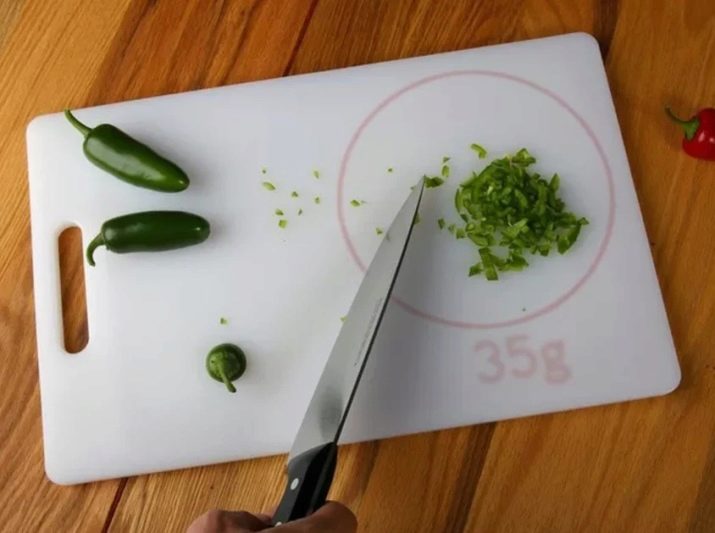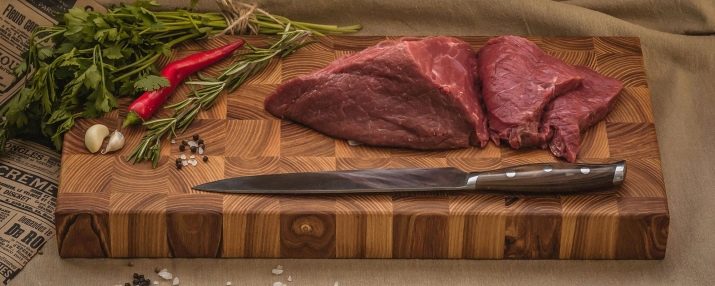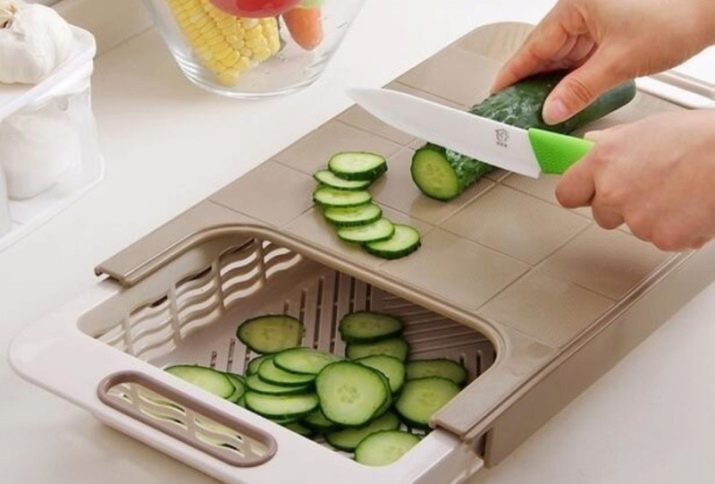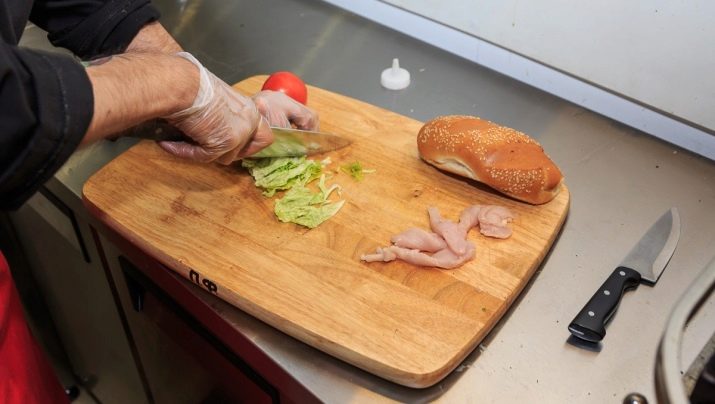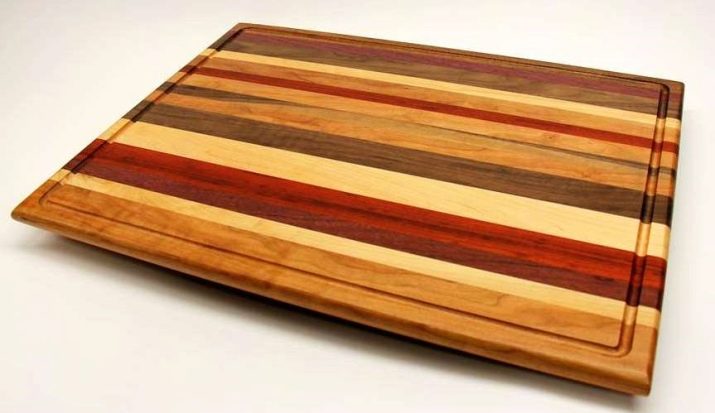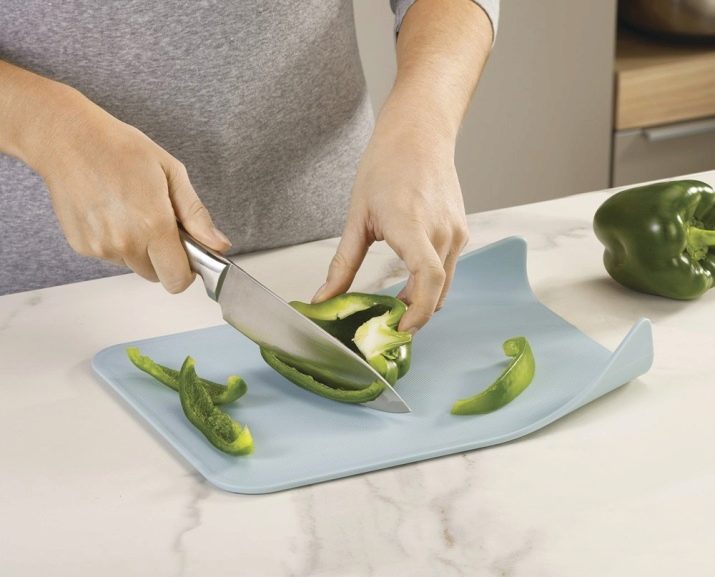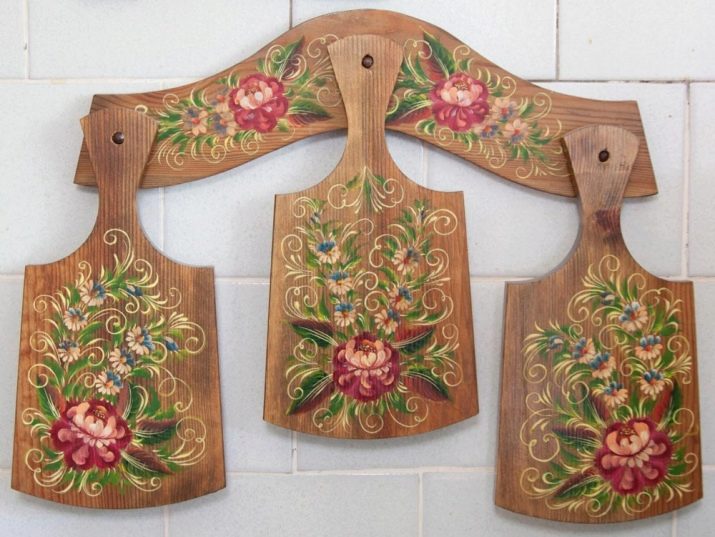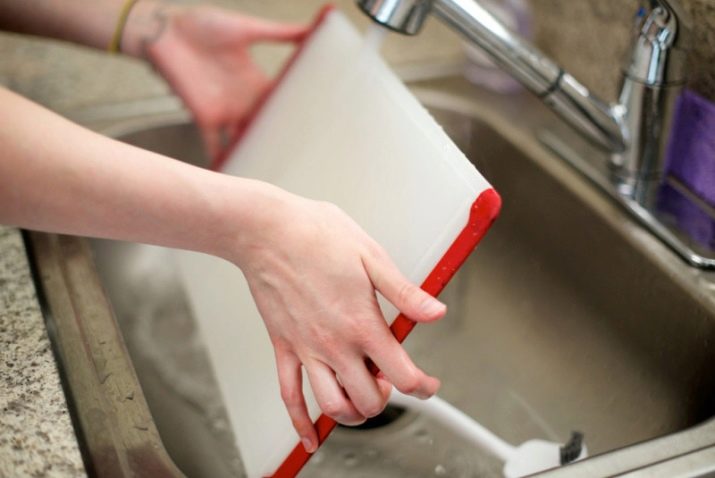Professionals say that a good housewife should have at least 3 chopping boards. But how to choose this minimum? Shops offer wooden, plastic, ceramic and a number of other boards. And they are large and small, square and round. The types, purpose and criteria for their selection will be discussed in this article.
What it is?
A cutting board is a well-known household item. It is used primarily for cutting or chopping products, thereby protecting the surface of the table and ensuring the safety of the process. Besides, utensils can be used as a stand for hot dishes, as well as these or other dishes are served on them..
Historical background allows to conclude that this useful kitchen accessory appeared in ancient times. For cutting then used large flat stones.
As technology improved, wooden boards appeared. People learned to process wood, and products from birch, oak, pine and beech appeared. For a long time, they were the only ones, but in the 40s of the twentieth century, silicone was invented, and then plastic products. They immediately gained popularity both among housewives and in professional circles, primarily due to their sanitary security.
A little later, glass analogues appeared. However, due to their fragility and a number of features, these products are more often used for serving. With the advent of plastic and glass boards, the history of wooden analogues has not ended. Moreover, their production technology has been improved. Solid wood products were replaced by glued boards, which turned out to be more practical. They were less deformed. Moreover, the popularity of wooden accessories once again began to grow along with the popularity of ideas of environmental friendliness and a healthy lifestyle.
Today, the European Union offers the color division of plastic boards, which indicates their purpose. So, white products are provided for dairy products, blue or blue for fish, seafood, red for raw meat, yellow for raw poultry, and green utensils are ideal for vegetables, fruits and greens.
What are the size and shape?
In the kitchen it is convenient to have several options of boards from large enough (for rolling out the dough, for example) to compact. Naturally, 2-3 medium-sized products should “fit in” between them. When choosing a product should focus on what products will be trimmed on the board.
For cutting meat, chicken, fish, a board of 3-4 cm is considered optimal. The average size is 30-50 cm.
For cutting vegetables and ingredients for salads, a product is enough, the size of which is 20 by 30 cm. The board is the same size for cutting bread. For greens, sausages, cheese, ingredients for sandwiches, even smaller ones will do.
The shape of the boards also have many options. The most versatile and convenient to store - rectangular or square. For bread and cheeses, as well as for pies, loaves, cakes, products are round. In addition, they look beautiful when serving. It can be not only bread and pies, but also toasted sausages with chopped vegetables and greens, shish kebab, cheese cuts.
Another convenient invention is the option at the corner of the table. As a rule, it is a square product with special legs. It is installed at an angle, and thanks to the steps, it is securely fixed and does not slide.
Often, utensils are shaped like fish, apples, etc. This is done not so much for diversity and attractiveness as for designating the purpose of the board. It is logical that the option in the form of fish will be used for cutting fish, so no one will confuse the product.
Varieties of materials
Depending on the material there are different groups of boards. Often it is the type of material that determines its purpose. Consider the most common options.
Tree
First of all, wooden boards are chosen for their environmental friendliness. However, it should be understood that this applies only to items made of solid wood. If it is a glued product, then a priori it contains synthetic components.
Wooden models have high strength. They do not split, do not crumble, but they are light enough (compared to stone, for example). At the same time, the strength of the wooden board for cutting products depends on the type of wood used.
The leaders here are products of acacia, oak. As a rule, they are used by professionals, and the boards themselves are distinguished by their high cost.
The optimal ratio of price and quality demonstrate options made of birch or beech. Even more affordable - pine products. However, due to the high hygroscopicity, they do not tolerate frequent washing. It is better to use them for cutting dry foods, such as bread.
But rubber models and hevea boards, on the contrary, are not afraid of frequent washing and excessively sharp knives. True, you can buy them only in fairly large specialized stores.
The strongest are end boards. They are thicker and heavier, made of hardwood. To know such a product can be on the location of wood fibers - they are perpendicular to the cutting surface. This ensures a long service life of the utensils, and also prevents the blunting of the knives. However, these boards need periodic maintenance - they need to be lubricated with special mineral oil.
Among the superstrong (but also expensive) boards are products made from American black walnut, Brazilian cherry and olive. Products from the nut array contains substances that provide its antibacterial properties.
It is understood that the most durable models - from the array. But glued counterparts split faster, but to a lesser extent susceptible to deformation under the influence of moisture. The most popular glued counterpart is plywood boards. They are quite suitable for cutting bread, greens, fruits and vegetables.
In any case, wooden boards should be protected from excessive moisture. In addition, they are afraid of too sharp knives and blows with wooden hammers (but the end can easily withstand such a "test").
Bamboo
Externally, these boards are similar to wood, but have a lower cost. This is due to the fact that bamboo grows very quickly. Unlike wood, bamboo is not afraid of moisture, does not absorb odors, has antibacterial properties. Such products are always glued, due to the characteristics of bamboo - it is hollow inside the tube.
Glass and glass ceramic
Glass cutting boards look stylish and modern. In addition, they are not afraid of frequent washing, easily disinfected. But it is important not to expose the glass accessory to the effects of contrasting temperatures when washing. Theoretically, glass products are suitable for cutting any products. However, attempts to repel meat on them or to cut hard pieces end in disrepair - the utensils are cracked. But for cutting fish, sausages, herbs, bread, they are very convenient.
A more durable counterpart is glass ceramic boards. However, they can not stand beats, falls, slicing too hard products.
It should be remembered that glass and glass ceramics blunt knives, so they are not suitable for everyday use. But glass accessories are attractive on the holiday table. You can serve them butter, cheese, herbs. Heat-resistant glass boards are suitable as a stand for hot dishes.
Plastic
Plastic products is the most common and affordable option. But this does not mean that the most inappropriate. Plastic boards (plastic must be food, safe) suitable for everyday use. They take cuts with sharp knives, they are easy to clean and disinfect. They do not slip, are not afraid of falls and blows.
Plastic transformers are very popular. If necessary, they can be bent to pour greens, for example. There are models with a sieve, so they can be used to wash fruits and vegetables, and then immediately cut those on the board. The folding plastic board is convenient on trips (outdoors, in the train).
Silicone
Silicone products can not be called a board for cutting in the usual sense. It is rather a flexible surface mat. However, it is convenient to cut vegetables and fruits on it, and due to the flexibility of the material, immediately bring them to the pan, bend and empty the products. Besides, silicone fits well to the table, is not afraid of bumps and falls, is equally “patient” with cold and hot water.
If high quality silicone is used, there are almost no traces of cuts and dents on its surface - it is restored. Suitable as a stand for hot dishes.
Stone
Stone products look respectable. They will decorate the kitchen or dining room - heavy, noble appearance. However, natural stone boards are hygroscopic, so they absorb stains and odors. Wherein they may break under the influence of contrasting temperatures when falling. Stone accessories easily absorb odors, their disinfection is also not an easy task. Avoid prolonged contact of products with acids. Finally, natural stone causes the blunting of knives, especially ceramic ones.
Polymeric analogue, the so-called artificial stone, is more practical. It is easier, easier to maintain, does not absorb odors. And the cost of such a board is 2 times lower.
Professionals prefer to use stone boards for dough cutting - it stays cool for a long time, thinly and evenly rolled out. Marble boards also have bactericidal properties.
Modern manufacturers often combine several materials. - wood and stone, plastic and silicone, wood and silicone. Sometimes they use completely unthinkable materials. For example, there is a board from Himalayan salt. It looks like a tile, has antibacterial properties, and in the process of cutting products are enriched with minerals.
Boards with additional functionality
Today, manufacturers offer boards with advanced functionality. For many, it is convenient and economical. In addition, when the board combines several useful functions, the hostess has the opportunity to save space in the kitchen.
Board breadbasket
It is a wooden board for bread (usually round), which has a glass, glass-ceramic or plastic cover. Such boards can also be used for pizza (must be the appropriate size of the product), pies.
For baguette slicing
It is a long and fairly narrow wooden plank with sides. The sides, in turn, are equipped with slots into which the knife is inserted. A bakery product is placed inside the accessory. Thanks to this adaptation, even the freshest baguette does not crumble or deform, and the pieces are always the same in thickness.
For cutting cheese
There may be several variants of such devices. First of all, it is a board with compartments in which various knives for cutting cheese are embedded.For hard grades of this product, the board can be equipped with a built-in knife or a taut fishing line. This allows you to cut hard cheese into thin slices.
A wooden cheese dock may have a glass lid (according to the type used in the bread box). This allows you to create the optimal microclimate, so necessary for the storage of cheese.
Finally, there are models that combine knives (stored on the back of the board or in pull-out boxes) and a transparent cover.
For washing
There are also many models, but they are united by their use. These boards are set on the sink to immediately wash and chop vegetables. Often they can be equipped with a colander. The best option, given the inevitable contact of the product with water, plastic and silicone.
With retractable container
Such products is a board in which there is a hole. Under this hole is placed retractable container. After the part of ingredients is cut, it is simply swept away in an opening and gets to the container. As the latter is filled in, it advances and the ingredients are poured into another dish for serving or further cooking. Boards with retractable container suitable for making salads, soups, stews.
Some models have several containers at once, which are also suitable for storage in the refrigerator and even in the freezer. In addition, these boards can be with containers for waste, they are convenient to cut onions, cucumbers and tomatoes - tails "go" in the container.
With weights
To combine 2 necessary devices in one is a truly brilliant solution. A board with weights is especially needed in the kitchen of confectioners, as well as those for whom the exact ratio of products is important.
Among unusual accessories with additional functionality, you can also select products with a tray for collecting liquids (a useful device if you cut juicy products). Quite often there are boards with rulers to make the pieces of the same thickness.
Interest is also a puzzle board. In the combined form, it is a familiar rectangular board, but if you wish, you can divide it into pieces-puzzles. The latter are used for individual submission. The important point is that such a board requires an extremely careful attitude. As a rule, these are wooden models.
One has only a little accessory to deform, as puzzles will no longer enter one into the other.
How to choose?
The choice of the board model should be based on its purpose. So, suitable for meat butt or stone board. The main criteria for her choice - strength, the ability to wash and disinfect.
The end face is also suitable for raw fish, however, it will serve less - it will absorb odors. If you cut chilled fish (and not chop frozen), it is better to take glass or glass-ceramic products.
For greens, vegetables and fruits it is better to take plastic or silicone boards, because they are easy to wash, and this will have to be done often.
For bread and cheese, always choose a separate board, as these products easily absorb extraneous tastes and smells. The main criterion is compactness, convenient options with a loop for hanging. as a rule, under these products acquire wooden products.
Wooden models for cutting meat and fish should have a special mark. Such boards are impregnated with special oils that provide antibacterial protection.
If you choose glass-ceramic boards with a pattern, make sure that it is applied on the reverse side. Otherwise, paint particles will be ingested. Since glass products slide on the table, it is better to choose models that have rubberized legs or lining.
It is rational to immediately think about the storage of the board. If it is suspended, it is more convenient to use models with a handle. However, such boards are not the best choice if you plan to store items in the table. Then the handle will occupy useful space.
As already mentioned, the size of the board is determined by its purpose. If you buy a large wooden board, let it be glued together, not monolithic. The last time will be deformed due to moisture. And if the deformations on a small-size wooden board may not be noticeable, then a large product will simply become impossible to use. In addition, a monolithic version of a large size can crack along the fibers.
Glued wood products have a fiber direction that compensates for possible deformations. Glued lamellae support each other, so the deformation of such products is less terrible.
But the glued versions are not suitable as a stand for hot. There is a risk that the glue will melt under the action of high temperature, and the board will fall apart.
When choosing plastic boards, it is important to ensure that the material is safe for humans. The greatest approval of the experts here is polypropylene. It is allowed for use in the food industry, is practical, easy and affordable price. However, this board is not suitable as a stand under the hot (melts at 70-80 degrees). It is undesirable to cut on it and hot foods.
Painted boards can be used only on the back side, where there is no pattern. But even this does not guarantee the preservation of the picture. As a rule, such products are souvenir and serve more to decorate the interior.
For the restaurant often purchase serving boards. However, nothing prevents to serve them dishes and at home. This is usually a set of 2-3 round or other unusual boards made of wood, ceramics or glass. Fried cuts of meat, burgers and french fries, baked fish, and cheese platter look appetizing on such boards. No less attractive to them and pastries - whether homemade cakes or delicious cupcakes.
Care Tips
Proper care of the board is not only an opportunity to extend its service life, but also care about your own health and the health of family members. After cutting the product on the surface can appear pathogenic microbes, causing serious poisoning.
Each type of product requires special care. So, products from plastic, silicone, glass and glass-ceramic can be washed in hot water with dish detergent. Then they must be wiped dry.
Wooden counterparts can be scalded with boiling water, and when spotting or bloating is detected, it is permissible to scrape with a knife. Do not soak wood products in water, keep near the stove. It is unacceptable to wash them in the dishwasher.
New wooden boards can be pre-prepared for use. - walk on the surface with fine sandpaper, remove wood dust, and then several times cover it with edible mineral oil. Apply it with a thin layer, then let the oil dry for 3-4 hours. After the indicated time, repeat the procedure another 3-4 times. This will protect the surface and provide it with antibacterial properties.
In the same way, you can restore the wooden board, frosted with knife marks. To do this, sand it and produce the steps described above.
Glass, plastic and stone products can be disinfected with soda, and the first two options - also with vinegar. By the way, vinegar removes odors from the surface.
If color or plastic stains remain on the plastic or silicone surface, you can try to remove them by preparing the paste from a mixture of soda and lemon juice. Add juice to the soda to make a wet gruel. It is applied to the stain and left for 15 minutes, then my board with warm water.
Keep cutting boards better not in the department where the dishes are dried (it may be too wet here), but in a special compartment of a kitchen set or hung on the wall. It is also important that the products do not touch, and water does not accumulate under them. Otherwise, do not avoid the appearance of mold.
How to choose the right chopping board, see the next video.
